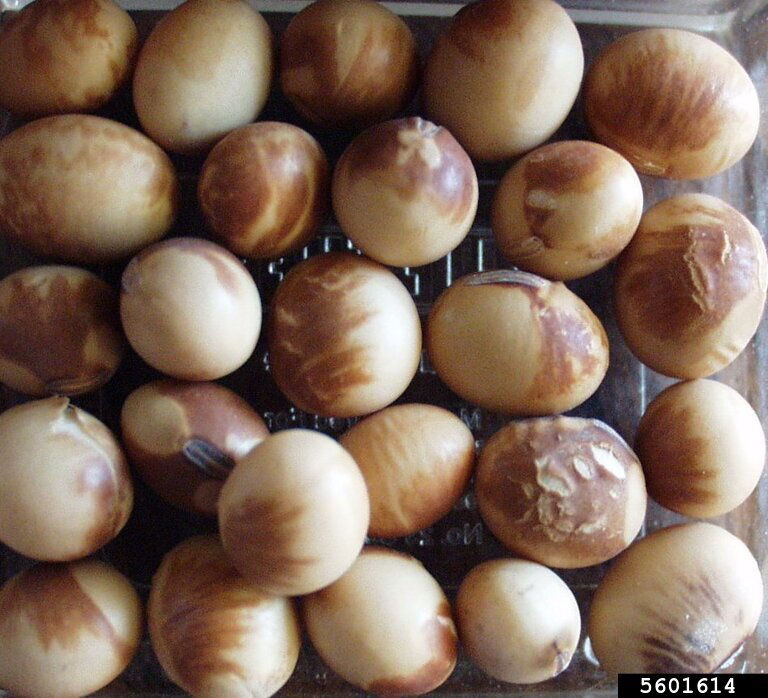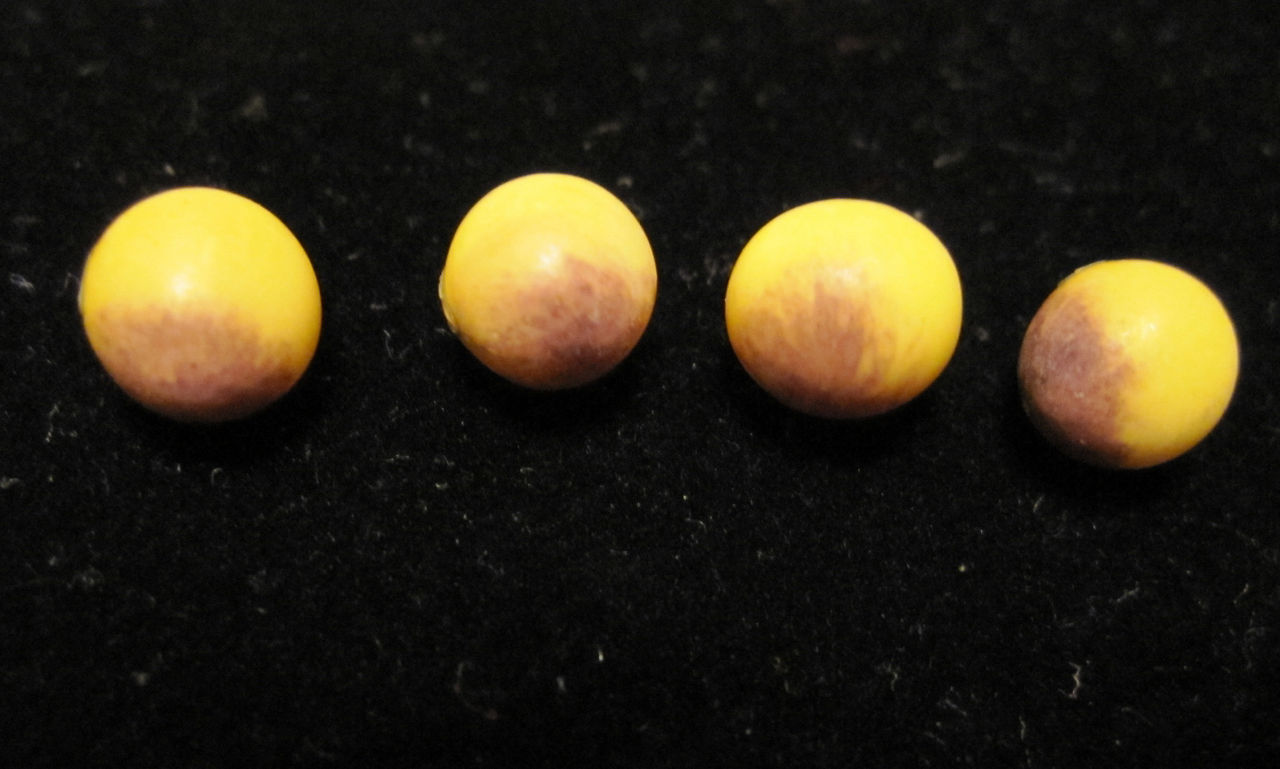7 MIN READ
Handling and Planting Lower Germination Soybean Seed
April 21, 2025
Soybean seed should always be handled with care because the seeds are fragile. Seed bags should NOT be thrown or dropped because doing so may reduce the stated germination rate. As seed moisture content decreases within the bag, the potential for seed damage increases if the seed is dropped from a given height (Table 1).1 Additionally, bulk seed that flows through augers or falls several feet into wagons can be damaged. Consideration should be given to the installation of a soft surface to cushion steel and plastic surfaces in seed tenders and planting equipment to help protect the seed when landing. Padded seed ladders may also be an option.
Table 1. Effect on soybean seed germinability when seed is dropped onto a hard surface from various heights and at various percent moisture contents.

Seed handling becomes increasingly important if the seed has a lower-than-normal germination percentage because of growing season issues. Growing season factors including diseases, insects, moisture (too little or too much), temperature fluctuations, and quick harvest drydown can affect the germination and appearance of soybean seed. However, poor appearance is NOT necessarily an indication of poor seed quality and visually pretty seed can also have a poor germination percentage.
Bulk Seed Handling
Handling soybean seed in bulk can help increase planting efficiency by reducing the down time associated with refilling planters, drills, and air seeders. However, because augers can transfer 10 to 15 bushels of seed per minute, there is a risk of up to five percent seed germination loss when seeds are split or seed coats cracked by the machinery.2 Equipment should be maintained in good condition, as worn augers, bearings, or motor mounts can cause increased seed contact with the flighting edges and result in damaged seed.
Belt conveyors running at five to eight feet per second result in high velocity seed leaving the nose of the conveyor. Installing padding at the nose can help cushion the seed.2 In an Ohio State University experiment, seed transferred by a conveyor belt without padding had notably lower germination compared to seed not handled through any bulk methods.2
Augers that are well supplied with seed and run at slower speeds can help minimize the potential for seed damage. Auger speeds reduced from 800 revolutions per minute (rpm) to 370 rpm led to improved germination rates of five to seven percent for steel and brush augers, respectively, in the Ohio State University experiment (Table 2).2
Table 2. Average percent soybean seed germination when seed is transferred by different auger speeds and types.*

Factors That May Affect Seed Appearance
- Seed coat damage may occur during the harvest and handling of low moisture content seed when relative humidity is very low.
- Growth marks usually occur when the seed coat doesn’t close completely. The cause is not fully understood but is believed to happen when the seed embryo develops faster than the seed coat.
- Bleeding hilum or seed coat mottling can be caused by genetics, stresses during seed development, or by soybean mosaic virus (SMV). Depending on soybean product and genetic hilum color, the mottling may be brown to black (Figure 1). For most soybean products, the seed transmission of SMV is less than five percent.3 Aphids are also a vector for SMV. Seeds infected with SMV have reduced oil content, seed germination, and seed quality. However, plants infected with SMV may not produce mottled seed and mottled seed is not indicative that the virus is present in the seed.3
- Purple seed stain occurs when the fungus Cercospora kikuchii causes seed to have a purple discoloration (Figure 2). Mildly infected seed may shed the seed coat before seedling infection can occur. Severely infected seed can transmit the fungus from the seed coat to the seedling at germination. Infected seedlings are likely to have reduced growth. Seed treatments can help prevent the transmission of the fungus to the seedling.4
- Greenish seed is characteristic of soybean plants subjected to an early frost. The green tint occurs because the chlorophyll has not fully dissipated. The coloration does not affect seed quality if the seed is mature.
- Seed size is influenced partially by genetics; however, the conditions of the growing season during seed fill affects seed size greatly. Small and large seed from the same soybean product have the same genetic material and have the same yield potential. Under most conditions, seed size does not affect germination or emergence. However, in adverse conditions, large seed (with a larger nutrient reserve) may be able to survive longer prior to emergence.


Seeding Rate Considerations for Lower Germination Seed
A healthy, consistent, and uniform population of 100,000 plants/acre (ppa) is generally considered a healthy soybean stand.5 However, the yield potential for uniformly lower populations can also be very good because of plant branching. The seeding rate recommendations to help attain maximum profitability and yield potential vary by seed product, geography, and local conditions. Bayer agronomists and field sales personnel can help with recommended seeding rates for the soybean products sold by Bayer companies. Local university agronomists are another source for information on seeding rates.
To help determine seeding rates, seed tags should be checked for the germination percentage and seed size for that lot of seed. Planting equipment should be adjusted for each seed lot to help provide a desired seeding rate and final stand. A general formula to help determine seeding rate is Desired Plant Population ÷ Percent Germination x Percent Pure Seed x Percent Live Seed Emergence = Seeding Rate.6 The percent live seed emergence estimate is not provided on the seed tag and is an arbitrary number determined prior to planting. The estimate should be determined on a field-by-field basis and is dependent on variables such as the type of planter or drill, field conditions, planting depth, soil type, and other factors. Typically, 90% is a good rule of thumb, but it should not be used in all situations.
Regardless of the bag tag’s germination percentage, achieving a desired seedling population is important because replanting can be expensive. This becomes increasingly important when growing stress in the seed production year has resulted in germination percentages around 85% instead of a more normal 90%. Stress in the previous growing may also make acquiring additional seed for replanting difficult, as a desired seed product could be in short supply. Seed lots with higher germination percentages should be planted before lower percentage seed, particularly if soils are cold. Planting into wet soils should be avoided regardless of germination percentage.
Sources
1Delouche, J.C. 2021. Maintaining soybean seed quality. Mississippi State University Extension Service, Seed Technology Papers. 101. https://scholarsjunction.msstate.edu/seedtechpapers/101
2Darr, M., Rethmel, B., and Reeder, R. Impact of bulk seed handling on soybean germination rate. The Ohio University, Found at Mississippi Soybean. https://mssoy.org/sites/default/files/documents/handling-bulk-seed-isu.pdf
3Giesler, L.J. Soybean mosaic virus. University of Nebraska-Lincoln Institute of Agriculture and Natural Resources, CROPWATCH. https://cropwatch.unl.edu/plant-disease/soybean/soybean-mosaic-virus/
4Giesler, L.J. Purple seed stain. University of Nebraska-Lincoln Institute of Agriculture and Natural Resources, CROPWATCH. https://cropwatch.unl.edu/plant-disease/soybean/purple-seed-stain/
5Anderson, M., Vittetoe, R., Licht, M., and Rieck-Hinz, A. 2020. Stand assessments – soybean. Iowa State University Extension and Outreach, Integrated Crop Management. https://crops.extension.iastate.edu/encyclopedia/stand-assessments-soybean
6Robinson, A.P. and Conley, S.P. 2007. Plant populations and seeding rates for soybeans. Purdue Extension, Soybean Production Systems. AY-217-W. https://www.extension.purdue.edu/extmedia/AY/AY-217-W.pdf
Web sources verified 4/14/25. 1316_99564